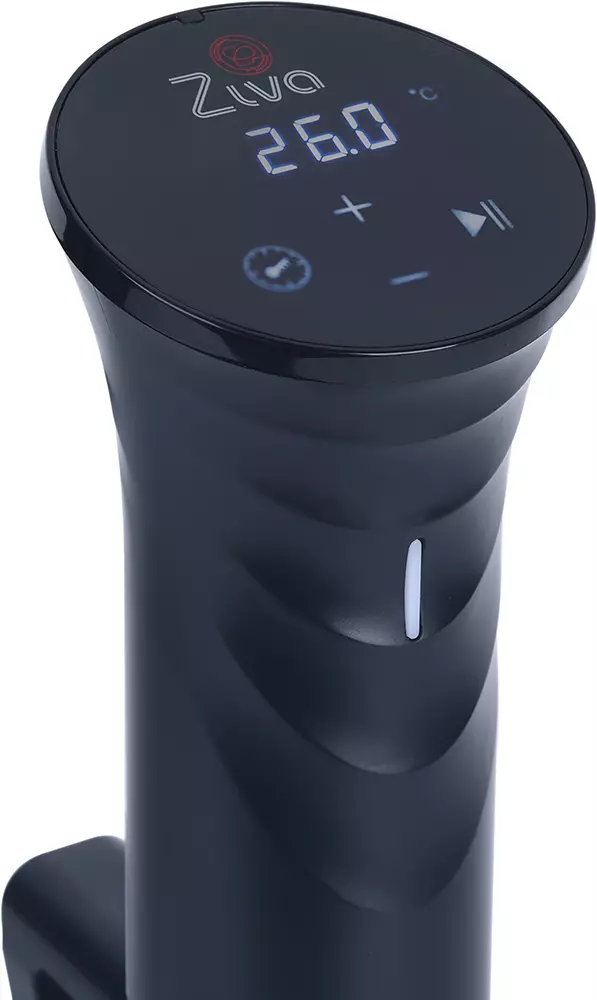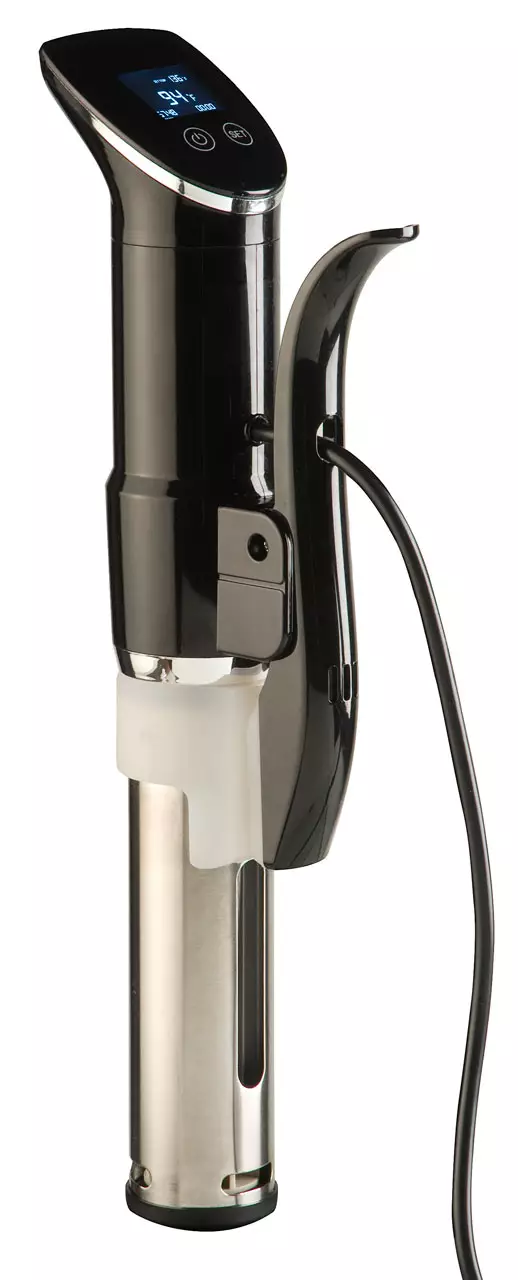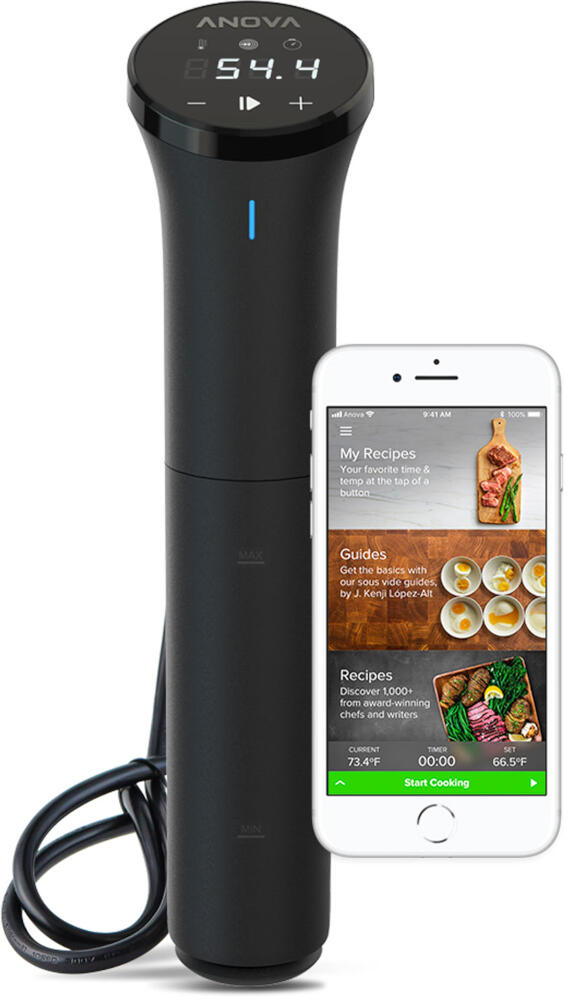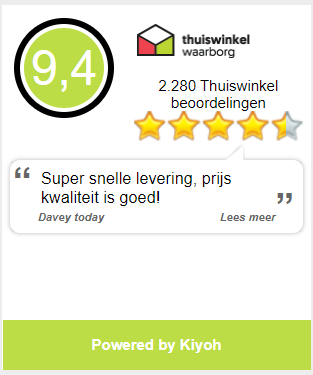Want to buy Sous Vide? You will find the best sous vide device here!
You've recently heard rave stories from your friends about sous vide cooking, and now you want to buy a sous vide. Which sous-vide device is the best and should you buy? In this article we explain the characteristics and differences of both and help you make the right choice.
There are roughly two different types of sous-vide devices:
- sous vide sticks
- sous vide water ovens
What is a sous vide stick?
A sous-vide stick is also called a sous-vide circulator, sous-vide (circulation) controller, sous-vide immersion heater, water bath heater, or water bath thermostat. They are relatively compact devices that you can place in a (suitable) water bath. This water bath can, for example, be a storage box or large pan, as long as the water level is sufficient for the minimum and maximum immersion depth of the stick. A good and affordable entry-level model is the Ziva Savant sous vide stick.
A sous-vide stick basically consists of a thermometer, a heating element, and a water pump with a propeller. The thermometer compares the temperature of the water bath with the set temperature and switches the heating element on or off based on this. The water pump ensures even heating of the water through circulation and turbulence.
The biggest advantage of sous-vide sticks is that they are compact and therefore take up relatively little space when you store them. However, during preparation, you still need a water bath/reservoir / large pan that is sufficiently deep for the minimum immersion depth of the sous-vide immersion heater. As a reservoir, you can use, for example, a bucket, a large pan, a cool box, and a storage box (such as those you can find cheaply at the large household chains). Please note that the container you use can withstand the temperature at which you want to prepare and that the outside can become warm or even hot (particularly important if you have children).
Benefits of sous vide sticks
- Compact and easy to store
- Very flexible in use due to variable reservoir
- Relatively affordable for larger reservoirs (15 liters and more)
- Relatively high power compared to size
Disadvantages of sous-vide sticks
- Less easy to keep clean
- Less energy efficient and more evaporation (can be solved with insulation balls)
Top 3 sous vide sticks
There are many different devices on the market today, including unfortunately many devices that are not very reliable or accurate. While accuracy is so important for consistent sous-vide results and food safety. Reliability is even more important because there is nothing worse than discovering in the morning that your sous-vide stick has failed and you have to throw everything away. We have specifically done something about this with the Ziva Sense sous-vide stick and this is one of the most reliable sous-vide sticks in our range that is also very affordable. SousvideKenner only sells high-quality sticks and we have already made a selection for you of the best sous vide sticks currently available.
#1 Ziva Savant sous vide stick
#2 Wartmann 1507 sous vide stick
#3 Anova Precision Cooker Nano 3
Our conclusion
Sous-vide sticks are ideal for smaller kitchens because of their compact size. Although they are less easy to clean, this is not a problem if the device is not used daily. In most cases, it is sufficient to simply rinse the sous-vide circulator thoroughly under clean water after use and occasionally treat it against limescale. Most sous-vide sticks are easy to disassemble.
We think the biggest advantage is the relatively large capacity compared to the price. A standard sous-vide stick can easily handle a 20-liter reservoir, and for a reasonable additional cost, you can get 40 liters, which is ideal for large barbecues where you want to pre-cook 40-60 portions. You can use a large pan as a reservoir and for a few euros, you can buy a 20, 30, or 40 liter storage box which is excellent. and can handle many portions (useful at parties, dinners, or barbecues, for example).
If you want to limit evaporation, floating sous-vide insulation balls are an excellent solution. These balls prevent up to 90% of heat loss through evaporation because they prevent contact between air and water. And if you want to prevent the walls of the reservoir from getting hot, you can, for example, wrap them with bubble wrap, which also improves energy efficiency. However, in most cases (short recipes) this is not a major disadvantage.
What is a sous vide water oven?
 A sous-vide water oven is also called a sous-vide water bath or sous-vide machine, and in some cases a sous-vide steamer when steam is used instead of water. A sous-vide water oven is basically a sous-vide stick with an integrated reservoir and works much the same. The advantage of water furnaces is their greater efficiency, mainly due to the insulation of the reservoir. This means the water heats up faster, the temperature is more stable and the walls do not get hot (safety). If you have the space, you are done in one go: you no longer need an (insulated) reservoir, nor insulating balls or lids. However, the price is often relatively higher for larger reservoirs.
A sous-vide water oven is also called a sous-vide water bath or sous-vide machine, and in some cases a sous-vide steamer when steam is used instead of water. A sous-vide water oven is basically a sous-vide stick with an integrated reservoir and works much the same. The advantage of water furnaces is their greater efficiency, mainly due to the insulation of the reservoir. This means the water heats up faster, the temperature is more stable and the walls do not get hot (safety). If you have the space, you are done in one go: you no longer need an (insulated) reservoir, nor insulating balls or lids. However, the price is often relatively higher for larger reservoirs.
A sous-vide water oven heats and circulates the water in a completely different way. The entire soil is a heating element and the thermal convective properties of water ensure its circulation; so no water pump is needed (with the exception of some hybrid water ovens). Here too, a thermometer compares the temperature and switches the heating on or off.
Benefits of sous vide water ovens
- Energy efficient and quiet
- Easy to clean (smooth surfaces, few/no moving parts)
- Safe to use because the walls do not get hot
- Always good (natural) circulation, unless the bath is extremely full of portions
Disadvantages of sous-vide water ovens
- Takes up much more space (comparable to a deep fryer or bread machine)
- Relatively uneconomical for larger reservoirs (from approx. 12 liters and more)
Our conclusion
Sous-vide water ovens are useful when you have enough space in your kitchen and appreciate a particularly low noise level and high energy efficiency. The energy efficiency is especially an advantage when you use longer cooking times (for example 40 hours). The insulated walls make the device safer because they do not get hot, so that is a consideration with children.
However, most water ovens are quite limited in terms of capacity and therefore the number of portions (or size of product) that you can fit in them. If you want more liters, you will have to pay (relatively) more, while a sous-vide stick is much more flexible and usually offers a larger capacity for the same price. For example, at a barbecue with 10 people, we found the capacity of a 12-liter reservoir too small for the number of portions (30) that we wanted to prepare in it; also because a reservoir that is too full can adversely affect the circulation and therefore the cooking of the product. It must be said that this is an exceptional case and will not easily occur when preparing a meal for a handful of people.
What do you need for sous vide?
What you need to get started with sous-vide:
- a sous-vide stick and a water reservoir. You can also use a pan or even a bucket, but we recommend a polycarbonate sous-vide water container.
- or a sous-vide water oven.
- a vacuum machine and vacuum bags or vacuum foil. Although this is not strictly necessary, we absolutely recommend using a decent vacuum machine for much better, more consistent sous-vide results. You can already have a vacuum machine for less than 60 euros and it is well worth the money.
Would you like to get started with sous-vide at an affordable price? Buy a sous-vide discount bundle!
Our Ziva Savant sous-vide discount bundle is by far the most affordable sous-vide starter set; carefully composed by our team of sous-vide experts. Knowledge makes the difference!







